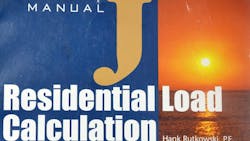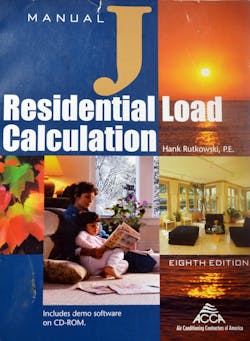The Air Conditioning Contractors of America (ACCA) has clearly published guidelines called Manual J on HVAC load calculations and Manual S on using those results to choose the right residential heat pump system. Specifically, Manual J should be used by contractors for producing HVAC equipment sizing loads for single-family detached homes, small multi-unit structures, condominiums, townhouses and manufactured homes. Manual S is a comprehensive guide that should be used for selecting and sizing residential heating, cooling, dehumidification and humidification equipment.
Manual J software is simply a calculator, so it’s only as good as the input it receives. If an HVAC contractor guesses or inputs the wrong information, they’ll get the wrong answer.
However, studies from the Department of Energy and my own conclusions from talking to HVAC contractors while teaching courses on Manual J show that slightly less than half of them do comprehensive load calculations. Instead, many HVAC contractors use inconsistent methods or guesswork, which can result in poor system performance.
But why are contractors not taking Manual J seriously? A question from a contractor in one of my recent courses illustrates the issue. “Is anybody going to notice?”
Yes. Building inspectors, manufacturers and distributors are starting to notice when load calculations are done incorrectly. When a heat pump system has a problem, the first thing these professionals ask for is the load calculation to verify whether the heat pump system was designed correctly.
How to NOT do Manual J calculations
Developed by the ACCA, Manual J, v. 8 for residential applications is American National Standard-accredited (ANSI-accredited) and written into the International Code Council (ICC) codebooks as a baseline for calculating HVAC loads.
Unfortunately, contractors often choose their own incorrect methods for calculating codes. Some use:
- The eyeball method – The tongue-in-cheek Manual E, better known as the eyeball method, happens when a contractor looks at a house and unscientifically determines tons of load the home needs based solely on the size.
- The finger method – A contractor stands across the street and holds up two, three, or four fingers to cover the house to determine how many boiler sections are needed. If three fingers cover the house, voila! A three-section boiler will work, the contractor thinks.
- The square-foot-by-ton method – A contractor makes a complete guess as to the load needed by calculating square foot by ton, without considering insulation, windows, direction and other aspects of the home.
Contractors have gotten away with using these methods because most are far from being experts in load calculations, and it’s not always enforced. One town might be strict and mandate a contractor follows Manual J, while another town takes payment for a permit without looking at the paperwork. The level of enforcement is drastically different from one locale to the next.
Completing a Manual J correctly isn’t complicated once a contractor learns what to look for and how to do one.
Four areas most-impacting heat loss and gain
The Manual J load calculation is a formula used to identify a building’s HVAC calculation – specifically the peak heating and cooling loads, or the heat loss and heat gain, needed for designing a residential heat pump system. Manual J can be used to determine heating and cooling for a home based on its physical location, the direction it faces, the humidity of the climate and insulation R-values of the walls, ceiling and floor, among other factors.
Manual J software is simply a calculator, so it’s only as good as the input it receives. If an HVAC contractor guesses or inputs the wrong information, they’ll get the wrong answer.
There are four main areas impacting heat loss and heat gain across the thermal boundary of a home.
Heat loss encompasses:
- Temperature difference – Calculations based on location and outdoor temperatures of the home, comprising 75% of heat loss.
- Air exchange/infiltration – Calculations based on a range of looseness to tightness of a home, determined by air changes per hour and square footage of a home, comprising 25% of heat loss.
If a heat pump is sized incorrectly, it is typically due to contractors guessing the temperature difference and infiltration rate rather than using Manual J.
Heat gain’s largest contributors:
- Solar heat gain – Fenestration, such as the placement of windows and glass doors, comprises 50% to 65% of heat gain.
- Internal gains – All appliances and people comprise about 15% of heat gain.
HVAC contractors should steer clear of non ACCA-approved Manual J software as it could be missing a critical component or simply hasn’t gone through the certification process.
Most HVAC contractors miss the internal gains portion of Manual J by adding too many people or inputting the wrong appliance block load amounts.
Choosing approved Manual J software providers
When performing a Manual J, I suggest contractors use one of these ACCA-approved Manual J v.8 software platforms to ensure compliance with building codes:
- Wrightsoft features an easy-to-use, drag-and-drop interface that enables a contractor to do room-by-room calculations.
- Elite RHVAC is often chosen by contractors who prefer worksheets and drawing floor plans for load calculations.
- Conduit Tech uses iPad LiDAR and iPad Pro to scan the home and windows to create a quick and accurate Manual J at no cost.
- Cool Calc is free to use but requires payment to generate a report. The contractor can tap on Google Maps, which pulls in a residence’s square footage.
- Carmel Software HVAC is an inexpensive choice that features a native IOS application which generates on screen reports in a similar worksheet style to other approved options.
- Adtek Acculoads are often chosen by contractors who prefer worksheet styles for load calculations.
HVAC contractors should steer clear of non ACCA-approved Manual J software as it could be missing a critical component or simply hasn’t gone through the certification process.
No more guesswork to complete Manual J correctly
The bottom line is that every HVAC contractor should perform an ACCA-approved Manual J to properly calculate loads for residential heat pump systems. In doing so, they will have the right information to perform an ACCA-approved Manual S so they install the right-sized heat pump system for a home, making homeowners happy while ensuring compliance with local building codes, regardless of enforcement.
Chris Morin is a seasoned Business Development Sales Manager at Mitsubishi Electric Trane HVAC US (METUS) with a proven track record in driving growth within the HVAC sector of Heat Pump Systems and Residential Air-Conditioning and Gas Heating, including sales, design, installation, service and maintenance.
This article is based on a presentation Chris Morin delivered at the Eastern Energy Expo, May 19-22, 2024.
About the Author
Chris Morin
Business development sales manager, Mitsubishi Electric Trane US (METUS)
Chris Morin is business development sales manager, Mitsubishi Electric Trane US (METUS).


